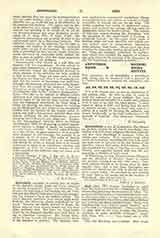

Abecedaria, complete or partial lists of letters of the alphabet, chiefly Greek and Latin, inscribed on ancient monuments, Pagan and Christian. At, or near, the beginning of the Christian era, the Latin alphabet had already undergone its principal changes, and had become a fixed and definite system. The Greek alphabet, moreover, with certain slight modifications, was becoming closely assimilated to the Latin. Towards the eighth century of Rome, the letters assumed their artistic forms and lost their older, narrower ones. Nor have the three letters added by the Emperor Claudius ever been found in use in Christian inscriptions. The letters themselves, it may be said, fell into disuse at the death of the Emperor in question. The alphabet, however, employed for monumental inscriptions differed so completely from the cursive as to make it wholly impossible to mistake the one for the other. The uncial, occurring. very rarely on sculptured monuments, and reserved for writing, did not make its appearance before the fourth century. The number of Christian objects bearing the Abecedaria, with the exception of two vases found at Carthage, is extremely limited. On the other hand, those of heathen origin are more plentiful, and include certain tablets used by stonecutters’ apprentices while learning their trade. Stones have also been found in the catacombs, bearing the symbols A, B, C, etc. These are arranged, sometimes, in combinations which have puzzled the sagacity of scholars. One such, found in the cemetery of St. Alexander, in the Via Nomentana, is inscribed as follows:
AXBVCTESDR …. BCCEECHI
EQGPH …. M MNOPQ
RSTVXYZ
This represents, in all probability, a schoolboy’s task, which may be compared with a denarius of L. Cassius Caecinianus, whereon the inscription runs thus:
AX, BV, CT, DS, ER, FQ, GP, HO, IN, KM
It is to St. Jerome that we owe an explanation of this curious trifle. He tells us that, in order to train the memory of young children, they were made to learn the alphabet in a double form, joining A to X, and so on with the other letters. A stone found at Rome in 1877, and dating from the sixth or seventh century, seems to have been used in a school, as a model for learning the alphabet, and points, incidentally, to the long continuance of old methods of teaching. (See Alphabet.)
H. LECLERCQ

